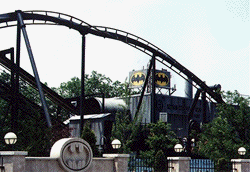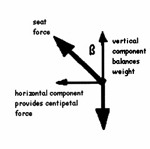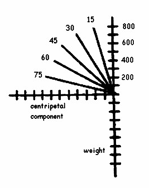


Before you ride: Locate the large horizotal curve. as you stand facing the ride (at the entrance to the ride's queue line), the large horizotal curve will be to your right. you may need to observe the train as it travels to locate this curve.
DATA:
Your mass = ________________ kg.
Your weight = _________________ N.
Time for entire train to pass point P at the side of the loop = ____________ s.
Angle of the train to the vertical (ß) = ___________ degrees. (See the diagram below on how to measure this angle)
Length of train = 12 m.
What would happen to the angle of the train, ß, if the rain were moving faster?
How would ß be affected if the raduis of the curve were larger?
While you ride:
Observations: while going around the horizontal curve...
Sensation: Circle One: (Normal, Heavier, Lighter)
Meter readings at P, along te horizontal curve = _____________ degrees.
On what part of you body did you feel forces being exerted as you rounded the curve? ___________________________
Even though the train was at such a great angle as it came around the curve, did you ever feel as if you were falling out? Explain.
QUESTIONS AND CALCULATIONS: (while rounding the large horizontal curve)
1. Use the length of the coaster and the time it took to pass oint P (in above diagram) to calculate the average spped of the coaster as it rounds the far turn. v = _____________________ m/s.
2. What type of force keeps you going around the curve?
3. What provides you with this force?
Two forces act on you as you ride, your weight and the seat force. They are shown iat the right in bold. The seat force has two components. The vertical component balances your weight. The horizontal component provides the centripetal force needed to make you follow the arc of the turn. Combined as vectors they give the force you are feeling.
4. Calculate the centripetal force on you. Fc = mv
/ r.
Fc = _________________ N
5. Draw to scale on the diagram given.
a. Your weight (in Newtons) pointing down.
b. The vertical component of the seat force pointing up
c. The horizontal component which is the centripetal force you calculated above.

6. Complete the vector diagram: Find the resultant
a. By approximating the length and angle on the diagram and
b. by calculation:

7. How do your calculated angle and seat force compare to the angle and seat force you measured? How can you account for discrepancies?
Any Other Observations of Questions?